

I travel the world constantly, uncovering, discovering and reviewing what’s happening in the world known as location-based virtual reality (LBVR) so I can deliver the most relevant insights to you. Since 2016 I have flown almost a million miles covering conferences, meeting with emerging startups, and talking to the leading minds in virtual reality. That’s 37 times around the planet, or to the moon and back…twice.

Now don’t get me wrong, I love it. I’m not looking for sympathy. This past month I got to work in Chicago, Paris, New Orleans and Hawaii. Next month is Moscow, Switzerland, and Budapest. I have manifested the most amazing life, working with people I like and admire, doing work I love wherever I want.
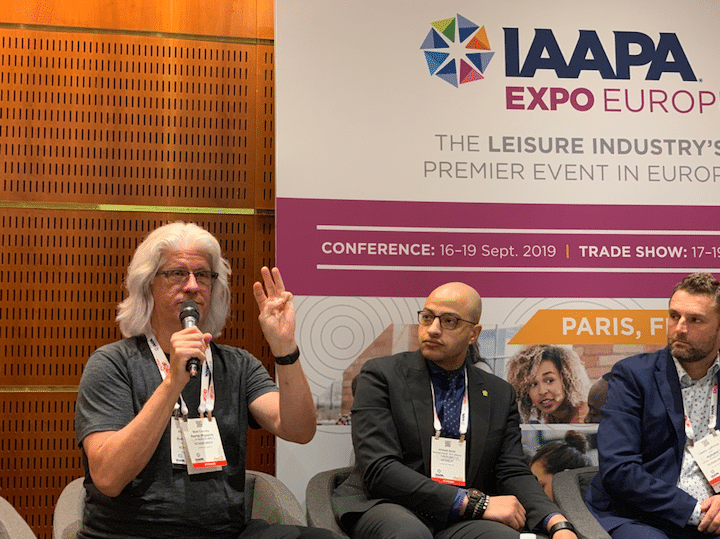
I was invited to speak at IAAPA Paris to help operators make sense of this crazy virtual reality thing. Most operators are confused as hell, sitting on the sideline wondering what to do with VR. I presented to a packed room my framework to help operators evaluate VR attractions and select the perfect one(s) for their unique situation. You can the download 33-page detailed version in my new Buyer’s Guide here for free. It’s NOT a buyer’s guide with ads from all the companies selling VR stuff. It’s a whitepaper that teaches you how to figure it out for yourself. If after you read it, you still need help, I have created a mentoring program that will help. You can learn more about that here or email me directly.
The show floor was packed with VR this year. Now I’ve been predicting this, so if you’ve been following me you might not be surprised. But every time one of my predictions comes true (which has been quite often during this 3rd wave of VR) I’m still a bit gob smacked, as my predictions tend to be counter intuitive. I was, after all, labeled a heretic in 2002 by Vending Times for encouraging arcade operators to adopt the consumer games model and share revenue with content creators, or suffer being usurped by the home games market. Yeah, that happened.
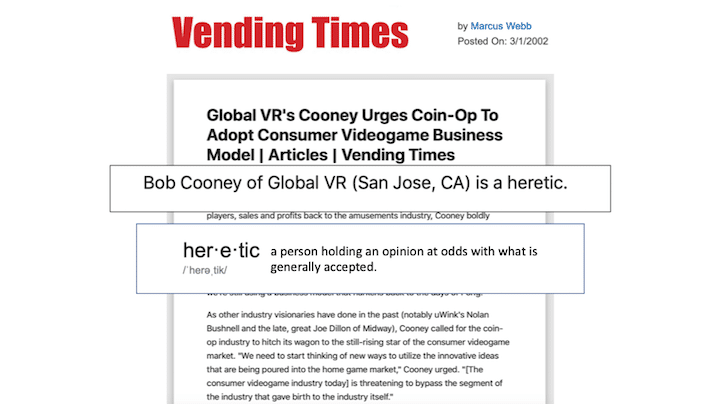
What I didn’t see coming was virtual reality giving us a second chance to get it right. Much of what is making its way into our industry is coming from the consumer games market, from hardware to content. And there is now a thriving revenue share model that’s driving more AAA content producers to bring their content to the amusement industry from companies like Ubisoft, Rovio, Survios, and others.
Orlando had over 60 VR exhibits last year. Paris, which was about 1/3 the size of the Orlando show, had at least that many this year. My expectation is that there will be more than 100 in Orlando in November. Here’s a wrap-up of the new stuff we saw in Paris and what it means to you.
Spree
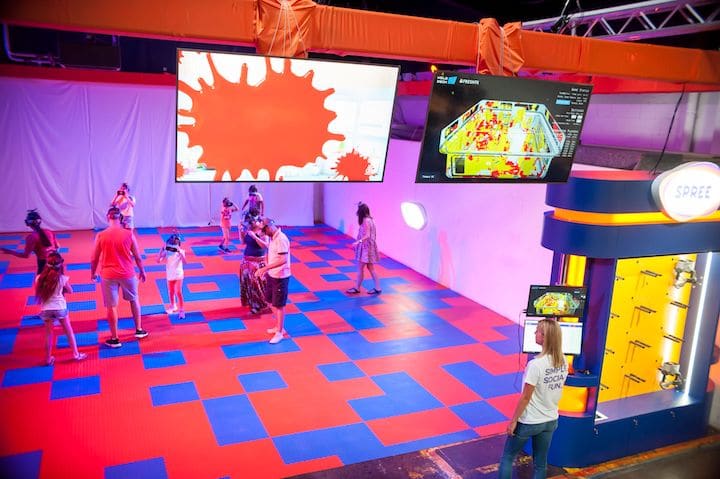
Recently rebranded from Holodeck VR, Spree Interactive was showcased at the IAAPA Theater, with a debut of their turnkey free-roam VR system designed explicitly for younger audiences. Using a mobile headset with no cables, backpacks or even computers, their suite of casual VR games is designed to be easily accessible to anyone from a 5-year old to grandmothers. I played their two newest games. Jump-a-Cheese, where you become a mouse on a tiny cheese planet, competing with other mice to jump and squash worms. It was still in development and needed some balancing yet. Their Anteater game was super fun. Nearly everyone that played loved it, and it’s one of the best examples of what everyone is calling for, non-violent games without shooting.
Their first permanent retail location just opened in a trampoline park in Germany. The owner announced that that on their first day of operation they ran more than 50 birthday parties of no less than 10 kids each through Spree to rave reviews. They bundled 3 mini-games into a 10-minute experience and charged a €5 per kid for the party upgrade. This equates to more than €2500 in additional revenue in the first day, which would seem to indicate an ROI in much less than 1 year, and an attraction that is sure to create word-of-mount in the community.
Illucity
Illucity is owned by Ymagis, one of the larger distributors of equipment and services to movie theaters in the world. Illucity is their laboratory to figure out what kind of virtual reality experiences might make sense for their theater operations clientele. They showed a 4-player multiplayer arcade system of their own development called with a music rhythm game called RagnaRock. In it players are on a Viking ship and have to time hammer hits onto musical notes, similar to guitar hero. I’m unclear why anyone would develop another system like this with more than a dozen already on the market.
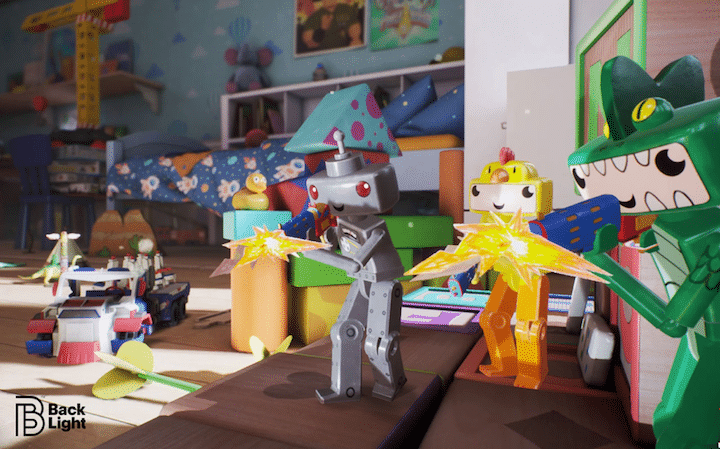
A tour of the Illucity flagship location in Paris uncovered what turned out to be the jewel of my trip. Toyland, a co-production with Paris’ Backlight Studios, is one of the best VR entertainment experiences I have played. It’s a 25-minute multi-mode story driven adventure. Players move back and forth from Dbox motion seats to free-roam shooting missions. The pacing is perfect, the dialogue is hilarious, and the art direction is worthy of major awards. Backlight continues to stand out from the pack as great storytellers in interactive VR entertainment experiences.
ModImage
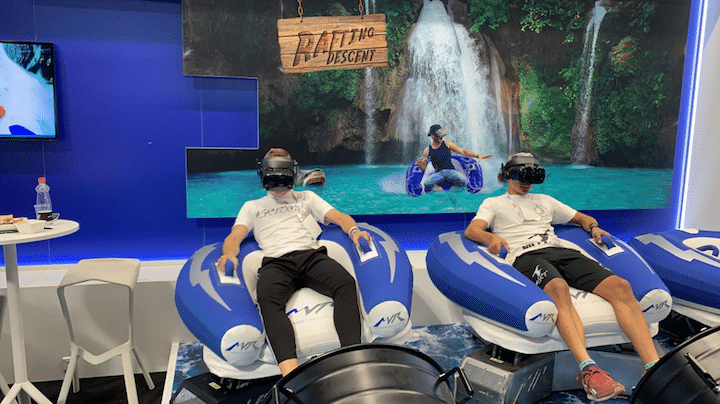
ModImage, a French interactive agency that specializes in retail brand activations showcased their flexible motion platform with two experiences. The water rafting adventure incorporated wind and extreme motion that was well-synchronized to the action. If you are in a waterpark, this feels like a no-brainer. The motion base also can be fitted with other “peripherals” like a snowboard, toboggan, etc, to enable different themed experiences. As such, it’s a true platform.
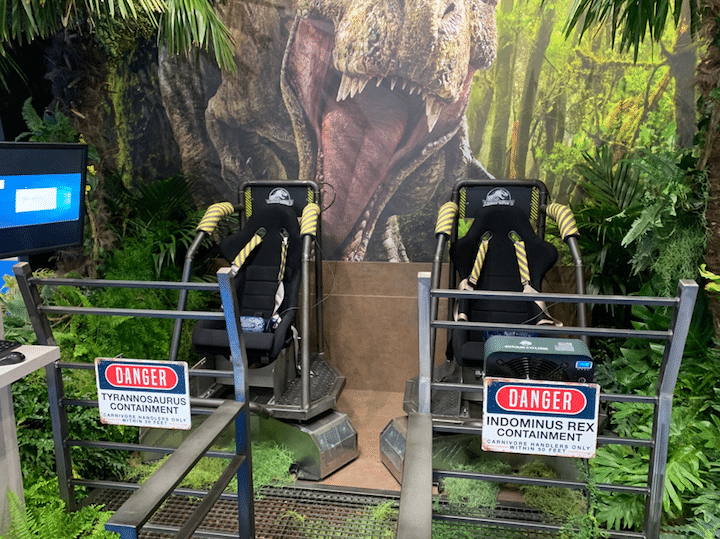
ModImage also showcased, running on the same platform, Jurassic World from The Virtual Reality Company who holds the license from Universal Studios. This is the same content that Dave and Buster’s launched across America last year, though I am unclear whether it’s interactive or just a passive ride, as they had not yet gotten it past the required inspections when I dropped by on Day 1.
Altereyes
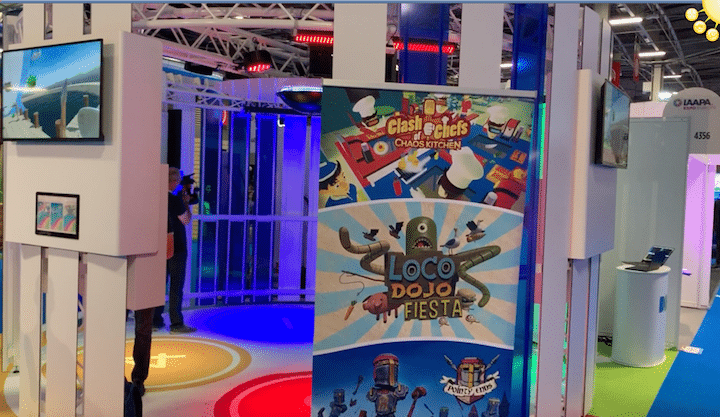
AlterEyes unveiled their version of a 4-player arcade system in the form of Dojo, and won best exhibit in their category from the show organizers. Dojo is a beautiful entry into the segment. It is white (I think we’ve seen enough black truss by now), round (funny how geometry can differentiate) and wireless (what?). The team at AlterEyes successfully hacked the Vive Wireless system to enable 4 players at once without any physical barriers. This makes the system more elegant, and enables players to utilize the entire space instead of just 25% in other systems in this category. I played a team-based competitive kitchen cooking game, similar to Job Simulator and We Dare Bears. It was chaotic, fun and has a high level of repeatability.
Nordic Amusements
One of the surprise hits of the show came from Nordic Amusements out of Sweden. I initially walked by their booth, which was a generic 2-player HTV Vive setup suspended from a black truss with a sign that said “distributors wanted”, wondering how a company could bring something so basic to such a crowded market at the largest amusement show in Europe. But over the ensuing days several of my trusted associates said I had to see the Nordic guys. I kept wondering who they were talking about, not making the connection. I presumed I just had not seen their booth yet.
When I finally tracked them down on the last day, I was perplexed. What on earth could everyone be seeing in this simple exhibit. I introduced myself to their CEO and even offered a mea-culpa for dismissing his booth the first time, which was a bit terrifying as he towered over me like Thor. I asked him for a demonstration, and despite my bizarre introduction, he warmly complied.
Their solution, Simvision VR, is unique in its simplicity. They’ve created 36 different mini-games across 4 themes, Anubis Temple, Action Island, Western, and Sci-Fi. Each game only takes a minute, and players or staff can setup up the games like a playlist. The system walks the players through the entire playlist, moving from one game to the next, with clear instructions and no operator intervention required. The games were fun yet challenging, with clear skill required to succeed. I played about a dozen of their games, and with one minor exception, they were all well-conceived and executed.
My problem with their product is that it does not have the curb appeal to attract players. In a modern FEC, it would look like a construction project. Too many companies are focused on selling an inexpensive product at the expense of building something that would attract players. No matter how cheap something is, if it doesn’t get played it’s a loser. I hope the guys from Nordic Amusements take this to heart and build an enclosure that is worthy of the content solution they’ve developed.
Hologate
The creator of the multiplayer arcade segment, Hologate, showed several new things at the show. They are the first company to upgrade their headsets to the new Valve Index, which offers a more comfortable fit, improved graphics and better sound over the Vive Pro. Most companies are moving slow when it comes to the Index, as Valve is notoriously fickle and has not offered a B2B licensing agreement. Hologate has sufficient scale and volume to secure supply chain, so it’s not surprising they’re the first.
They also showed a sneak peak of a new player vs. player (PVP) game that’s still in development. The player uses a hand-over-hand movement to traverse an offshore oil rig, while shooting opponents and trying to stay out of site. It felt inspired by classic stealth games like Splinter Cell, and offers a different movement mechanic that feels more intuitive than teleportation, which is what most PVP games use. PVP is hard to pull off – you need lots of leveling and balancing, and the game was still too early in development for me to make a call the quality.
Hologate also teased their newest solution, the Blitz, a 6 degree of freedom (DOF) interactive sim that is designed to emulate flying and driving. Pricing is suggested to be north of $200K for a 4 -player system, and no games have been shown yet. The product will be first shown at IAAPA Orlando and will be built and distributed, at least in the US, by Creative Works.
Where most of Hologate’s competitors seem to be trying to move down the pricing ladder, it’s interesting to see Hologate themselves move up to a significantly higher priced product. Most operators are underpricing their VR attractions. It will be interesting to see how they react to an attraction that might require 2X the ticket price to gain the same return on investment timeline.
There was so much VR at the show that I can’t possibly cover it in one post. Next week I will cover the rest of the show, and talk about the how the Oculus Quest could totally change the way we look at VR in the location-based entertainment business.